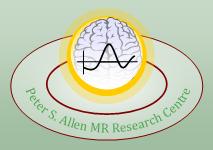NMR
What is Nuclear Magnetic Resonance (NMR) about?
Nuclear magnetic resonance (or NMR) refers to the ability of certain nuclei to emit useful signals when these nuclei are subjected to a strong static magnetic field and then excited by another strong but varying magnetic field. This signal is then recorded during a session and decoded into valuable information.Organic material is made up of a wide variety of molecules that comprise largely of hydrogen and carbon atoms. There are also intermediate numbers of other atoms like oxygen, nitrogen, phosphorous, iron, and sulfur as well as numerous trace elements such as selenium, chromium, and others. To be useful in NMR, a nuclei must be magnetic, ie, have a nuclear magnetic moment. Of all of the atoms within the body, the 1H atom is of the most interest. It generates the largest signal and is therefore the most valuable for in vivo NMR experiments.
There are three principal stages in an NMR experiment:
- Preparation of the nuclear magnetic system
- Excitation (or perturbation) of the nuclear magnetic system
- Acquisition of the signal from the excited nuclear magnetic system before it relaxes back to its equilibrium state
Preparation of the System
Within a body, the magnetic moments of all of the atoms are random. This results in a body having a total magnetic moment of zero. However, when placed with a uniform, static magnetic field, the moments will redistribute themselves to parallel and antiparallel to the direction of the field. The result of this is to generate a net magnetization within the body. The nuclei resonate in unison and are able to generate a much stronger signal. This process is called polarization and prepares the body for the phase of the NMR experiment.
Excitation of the System
A second magnetic field is applied to the system. This field is rotating in a plane perpendicular to the first, static magnetic field. The rotation is at radio frequency (RF), and it is tuned carefully so that the nuclei will resonate with the field. This resonance causes the moments of the nuclei to move from their polarized positions. After the second field stops or changes (it pulses as well as rotates), the nuclei will return to their polarized state. In doing so, a signal is emitted by the nuclei.
Acquisition of the Signal
The signal that is generated by the nuclei is picked up by sensitive voltage detection equipment. There are also phase angle detectors that receive information about positioning and timing of the signal. All of this information is processed to generate useful information about a system or body.
NMR, MRI and Nobel Prize
The resonance phenomenon is governed by a simple relation between the strength of the magnetic field and the frequency of the radio waves. For every type of atomic nucleus with unpaired protons and/or neutrons, there is a mathematical constant by which it is possible to determine the wavelength as a function of the strength of the magnetic field. This phenomenon was demonstrated in 1946 for protons (the smallest of all atomic nuclei) by Felix Bloch and Edward Mills Purcell, USA. They were awarded the Nobel Prize in Physics in 1952.Other fundamental discoveries concerning magnetic resonance have in recent years resulted in two Nobel Prizes in Chemistry. In 1991, Richard Ernst, Switzerland, was awarded for his contributions to the development of the methodology of high resolution nuclear magnetic resonance spectroscopy. In 2002, Kurt WŁthrich, also Switzerland, was awarded for his development of nuclear magnetic resonance spectroscopy for determination of the three-dimensional structure of biological macromolecules in solution.
In 2003, Paul C Lauterbur and Peter Mansfield were awarded The Nobel Prize in Physiology or Medicine for their discoveries concerning "magnetic resonance imaging".
Read more about Nobel Prize awards or play the Eduational MRI game.
More about principles of MRI: The basics of MRI


